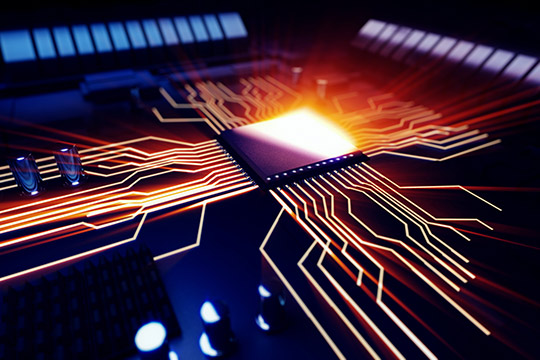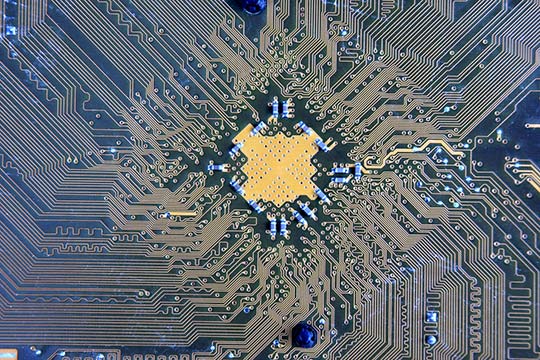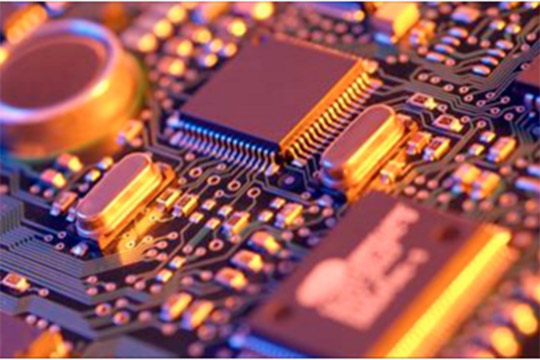TECHNOLOGY FOCUS
The relentless drive to miniaturize semiconductor devices starting with the invention of the transistor in 1947 and the integrated circuit twelve years later has been largely made possible due to innovations in semiconductor lithography and new materials. A testament to these innovations is the sheer ubiquity of electronic devices made with these integrated circuits that make up the technical inventory of our modern life. The cost, throughput, and resolution of the semiconductor lithographic patterning processes are the main imperatives that are driving these innovations. EUV lithography is in high volume production today at 7 nm technology node and gearing up for the transition to 5 nm technology node at leading edge Fabs. With many new fabs under construction in many parts of the world, there is an urgent need for people with expertise in semiconductor lithography to work in them and to help to develop the future generations of integrated circuit devices.


COURSE CONTENT
This course explores the physical and chemical basis of semiconductor lithography, which in all its essential aspects is about chemical transformations initiated by physical radiations that are designed to print a relief image of an object on a flat surface. The object may be a mask containing patterns of integrated circuit devices; the flat surface may be a silicon wafer coated with photo- or radiation-sensitive resist, which upon exposure and development, is transformed into the relief image of the mask. Underlying these transformations are distinct chemical reactions that are mediated by electrons. By drawing on fundamental, theoretical, and experimental studies of molecular processes in semiconductor lithography, including optical, extreme ultraviolet, electron beam and ion beam lithography’s, we will deconstruct lithography into its essential chemical and physical principles.
On a practical level, the course will provide a full overview of the exposure systems, operational principles and theories that underpin the various semiconductor lithographic techniques; strategies, processes, and materials used in their operations; their unique features, strengths, and limitations; and specific applications to which they are targeted. Also covered in the course are status, technical challenges, scaling, and future trends of semiconductor lithographic technologies in general.
WHO SHOULD ATTEND
This course is intended for scientists and engineers who wish to expand their knowledge of semiconductor lithography. Although the emphasis is on the fabrication of leading-edge integrated circuit devices, much of the information presented should be applicable to the patterning of other devices used in fields as varied as sensing, energy transduction and storage, biotechnology, photonics, catalysis, etc.

DAY 1 - INTRODUCTION TO SEMICONDUCTOR LITHOGRAPHY
Module 1 – Overview of semiconductor lithography
a. Introduction to lithography
b. History
c. Overview of semiconductor lithography
d. Moore’s law & International Technology Roadmap for Devices & Semiconductors
e. Semiconductor lithographic patterning challenges and status
f. Summary
Module 2 - Semiconductor lithographic process
DAY 2 - PHOTOLITHOGRAPHY
Module 3 - Optical lithography
1. Introduction
a. Elements of optical lithography
b. Printing modes
1. Contact printing
2. Proximity printing
3. Projection printing
c. Fresnel diffraction
2. Exposure tool optics
a. Huygen's principle
b. Image formation
1. Fresnel diffraction
2. Fraunhofer diffraction
3. Role of the objective lens – numerical aperture (NA)
4. Partial coherence theory of image formation
c. The Fourier Transform
d. Isolated and dense features
3. Resolution performance of projection systems (steppers and scanners)
a. Diffraction limited resolution
b. Depth of focus (DOF)
4. Exposure sources
a. Discharge lamps
b. Lasers
c. Impact on the direction of lithography
5. Illumination
a. Coherent, incoherent, partially coherent
b. Limiting resolution for conditions of coherency
c. The partial coherence factor (s)
6. The aerial image
a. Measuring imaging performance
1. Contrast
2. Modulation transfer function
3. Exposure latitude
4. Image log slope (ILS) and normalized image log slope (NILS)
5. Exposure-defocus window
b. Optimization of NA and s
7. Optical materials
8. Masks
a. Mask types and materials
b. Mask making
9. UV photochemistry within the exposure optics system
a. UV photochemistry of gases in exposure medium
b. Photo-oxidative degradation of resist polymers
c. Inorganic salt formation on masks and reticles
d. Corrosion of mask metallic absorbers
e. Photo-induced degradation of mask glass substrates
10. Resist Materials
a. Negative resists
1. Crosslinking resists
2. Photopolymerization resists
3. Polarity change resists
b. Positive resists
1. Chemistry of diazonaphthoquinone/novalac g/i-line resists
2. Chemistry of chemically amplified resists
i. Poly(hydroxystyrene) platform resist materials.
ii. Acrylate platform resist materials.
11. Reflectivity and control
a. Reflectivity effects
b. Bottom ARC
1. Organic approaches
2. Inorganic approaches
c. Top ARCs
12. Optical lithographic technologies & their performance
a. i-line (365 nm) lithography
b. KrF (248 nm) lithography
c. Dry ArF (193 nm) lithography
d. Immersion ArF (193 nm) lithography
13. Advanced resist processing & resist resolution limitation issues
a. Multi-layer resist systems
b. Post-exposure-based CD shrink techniques
1. Reflow CD shrink techniques
i. Thermal reflow shrink technique.
ii. Electron beam-induced CD shrink techniques.
2. Chemically induced CD shrink techniques
i. Chemically induced CD shrink techniques based on sidewall formation.
ii. Chemically induced CD shrink techniques based on sidewall erosion.
iii. Plasma-assisted CD shrink techniques.
c. Double exposure techniques
d. Double patterning techniques
a. Lithography-etch-lithography-etch patterning scheme.
b. Lithography-freeze-lithography-etch-patterning scheme.
c. Self-aligned double patterning scheme
14. Summary
a. The big picture
b. Status & outlook
DAY 3 (FIRST PART) PHOTOLITHOGRAPHY CONT’D.
Module 4 – EUV lithography
1. Introduction
a. Wavelength consideration
b. Advantages of EUVL
c. Key differences from optical lithography
d. Technical challenges
2. EUVL exposure system
a. EUV optics
1. History
2. Early optical systems, prototypes, and preproduction
3. Optical modules for high volume manufacturing
b. Multi-layer mirrors
c. Optics lifetime
d. Optics contamination
e. Contamination mitigation strategies
3. EUVL sources
a. Technology overview
b. Types
1. Laser produced plasma sources
2. Discharge produced plasma sources
3. Free electron laser plasma sources
c. EUV collector and debris mitigation
d. Out-of-band radiation
e. Source technology status and outlook
4. EUVL masks
a. EUV mask structure and fabrication process flow
b. EUV mask substrate
c. Multilayer mirror deposition
d. Absorber stack and pattern fabrication
e. Mask contamination & cleaning
f. Thin EUV mask structure
5. EUV resist materials
a. Chemically amplified poly(hydroxystyrene) platform resists materials
b. Metal oxide resists
c. Metal oxo/hydroxo and peroxo network/organic ligand resists
6. EUVL patterning performance
1. EUV patterning capabilities and extendibility
2. Resolution/line edge roughness/sensitivity trade-offs
3. Shot noise, stochastics & patterning challenges
7. Summary
a. The big picture
b. Status & future outlook
DAY 3 (SECOND PART) – CHARGED PARTICLE LITHOGRAPHY
Module 5 – Electron beam lithography (EBL)
1. Introduction
2. Exposure system
3. Types of EBL
a. Electron beam direct write lithography (maskless)
1. Scanning strategies
b. Electron projection lithography
1. Scattering with angular limitation projection electron beam lithography
2. Projection reduction exposure with variable axis immersion lens electron beam lithography
4. Resist materials
5. Patterning performance
6. Summary
a. The big picture
b. Status & future outlook
Module 6 – Ion beam lithography (IBL)
1. Introduction
a. Focused ion beam lithography
2. Ion-solid interaction
3. Exposure system
a. Ion sources
b. Ion microscopes
i. Ga ion microscope
ii. He ion microscope
iii. Ne ion microscope
c. Ion projection systems
d. Multi-beam systems
4. Ion beam lithographic patterning
a. FIB milling and gas-assisted processing.
b. Resist-based IBL
c. 3D patterning by ion implantation
d. Direct patterning of hard mask layers
5. Summary
a. The big picture
b. Status & outlook

